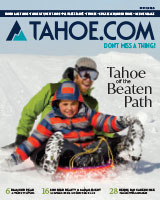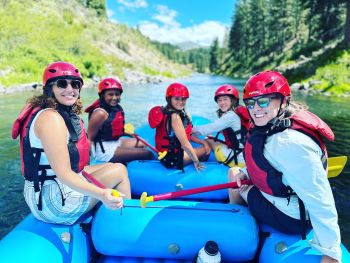One of the special aspects of Lake Tahoe is all the amazing backcountry opportunities. This is especially the case when it comes to backcountry skiing. Truckee and the surrounding communities of Lake Tahoe are blessed with a plethora of skiing and snowboarding options in the natural and uncontrolled mountains. Here's a little sampling of the tasty runs that await if you are willing to put some time into understanding snow science and then expend a bit of energy and sweat on the way up.
Truckee
Truckee is a buffet of backcountry skiing options. From basic beginner terrain that is great for getting to know the ways of skinning up hill to steep to dangerous lines that are only for experts, Truckee has it all. One of the largest hot spots is Donner Summit. Access is either by the ASI mountaineering school or the neighboring Sugar Bowl ski area. There is a full range of experiences for all ability levels. One is also able to access the backcountry ski huts, Peter Grubb Hut and Benson Hut, from this point. Another area that is close to Donner is Castle Peak, accessed via Interstate 80, taking the recreation exit directly after the first rest area stop after leaving Truckee. Another exceptional backcountry zone that also offers a hut is the Coldstream Canyon off Highway 89, before Palisades Tahoe when traveling south. Giving access for backcountry skiers, snowboarders and cross-country skiers, this is also the trailhead for Lost Trail Lodge.
Palisades Tahoe and Alpine Meadows
The backcountry for Palisades Tahoe and Alpine Meadows is more sidecountry than backcountry, meaning that you access it via the chairlifts from either ski area. Zones like Granite Peak and the Palisades from Palisades Tahoe are favorites for those who like to get extreme. The backside of Alpine does offer truer backcountry options like Grouse Rock or steeper versions with more work to get there, such as Twin Peaks.
West Shore
The West Shore of Lake Tahoe has a few major options when it comes to backcountry skiing or snowboarding. One of the most direct and beautiful descents available in Lake Tahoe is Jakes Peak. A 2,000-foot vertical descent that offers various options for the downward fun, Jakes is better for those with experience in the backcountry than for beginners. Another favorite on the West Shore of Lake Tahoe is Blackwood Canyon, 7 miles from Tahoe City. A closed off-road in the winter, this is the perfect place to enjoy the serenity of Tahoe. There is also a snow play area and easy parking. Another giant area on the West Shore for backcountry skiing that requires a little more effort but yields high returns is Desolation Wilderness. There is a giant array of lines, ranging from beginner to expert in Desolation.
North Shore
The backcountry skiing of North Shore is limited to the few areas that lead off the pass of Highway 267. These small backcountry areas tend to be quieter than zones like Jakes Peak or Grouse Rock. They are also wonderful for those who want to take things slow when it comes to the learning the curve of backcountry skiing as the terrain is mellower and thus friendlier to a beginner.
Incline Village
Incline Village is full of backcountry skiing options. The largest selection is on Mt. Rose, especially off the top of the pass. This is also where skiing will be found in early season and with the first snowfall of the year. Other backcountry options include Tamarack Peak and Relay Peak, both giving great steep options as well as intermediate runs. Plus, these all have the great bonus of being roadside attractions, meaning there is very little approach necessary for true access to the peak to begin.
South Lake Tahoe
South Lake Tahoe has the largest number of choices when it comes to backcountry skiing. From huge peaks like Freel to classic ascents and descents like Mount Tallac, there are a ton of different options. A few areas just in the direction of Kirkwood Ski Area alone include Carson Pass, Elephants Back, Waterhouse and Red Lake Peak. Angora Peak and its surrounding mountains also offer a diverse number of lines to ski and snowboard.
To learn more about avalanche conditions please visit the Sierra Avalanche Center.






